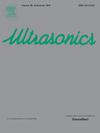Ultrasonic-enhanced flocculation and sedimentation of lead-zinc tailings: mechanisms and efficiency improvements
IF 3.8
2区 物理与天体物理
Q1 ACOUSTICS
引用次数: 0
Abstract
As global mining activities continue to increase, the accumulation of tailings presents significant environmental and social challenges. Traditional tailings treatment methods often struggle with efficiency and cost-effectiveness. Recently, ultrasonic technology has emerged as a novel and efficient approach, showing the potential to enhance the flocculation and sedimentation processes of mineral tailings. This study aims to investigate the mechanisms by which ultrasonic treatment enhances the flocculation of lead–zinc tailings. The research examines changes in particle properties, floc structure, and filter cake filtration performance of lead–zinc tailings under different flocculant systems before and after ultrasonic treatment. The results demonstrate that ultrasonic treatment significantly increases the contact angle of tailing particles, indicating enhanced surface hydrophobicity. Specifically, the contact angle increased from 52.0° in untreated tailings to a maximum of 66.5° after ultrasonic treatment with the addition of flocculants. Furthermore, zeta potential measurements reveal that the absolute value of the zeta potential decreased from −31.31 mV to −28.69 mV, −21.23 mV, and −14.59 mV after ultrasonic treatment with flocculants 02, 06, and 10 s, respectively, facilitating particle aggregation. Adsorption tests show increased flocculant adsorption on particle surfaces after ultrasonic treatment, promoting better flocculation. The ultrasonic treatment reduces the viscosity and surface tension of the filtrate, forming a more stable flocculation system and improving filtration efficiency. Moreover, the study found that ultrasonic treatment significantly increases the size and strength of flocs. These findings provide a comprehensive understanding of the interactions between tailing particles under ultrasonic action and offer valuable insights into the efficient treatment of tailings in mining operations.
超声强化铅锌尾矿絮凝沉降:机理及效率的提高
随着全球采矿活动的不断增加,尾矿的积累带来了重大的环境和社会挑战。传统的尾矿处理方法往往与效率和成本效益作斗争。近年来,超声波技术作为一种新颖而有效的方法出现,显示出增强矿物尾矿絮凝沉降过程的潜力。本研究旨在探讨超声处理提高铅锌尾矿絮凝效果的机理。研究了超声波处理前后不同絮凝剂体系对铅锌尾矿颗粒性能、絮团结构及滤饼过滤性能的影响。结果表明,超声波处理显著提高了尾矿颗粒的接触角,表明其表面疏水性增强。其中,接触角由未处理尾矿时的52.0°增加到添加絮凝剂超声处理后的66.5°。此外,zeta电位测量结果表明,絮凝剂02、06和10 s后,zeta电位的绝对值分别从- 31.31 mV降至- 28.69 mV、- 21.23 mV和- 14.59 mV,有利于颗粒的聚集。吸附试验表明,超声处理后絮凝剂在颗粒表面的吸附增加,促进絮凝效果的改善。超声波处理降低了滤液的粘度和表面张力,形成了更稳定的絮凝体系,提高了过滤效率。此外,研究发现超声波处理可以显著提高絮凝体的尺寸和强度。这些发现提供了对超声波作用下尾矿颗粒之间相互作用的全面理解,并为采矿作业中尾矿的有效处理提供了有价值的见解。
本文章由计算机程序翻译,如有差异,请以英文原文为准。
求助全文
约1分钟内获得全文
求助全文
来源期刊

Ultrasonics
医学-核医学
CiteScore
7.60
自引率
19.00%
发文量
186
审稿时长
3.9 months
期刊介绍:
Ultrasonics is the only internationally established journal which covers the entire field of ultrasound research and technology and all its many applications. Ultrasonics contains a variety of sections to keep readers fully informed and up-to-date on the whole spectrum of research and development throughout the world. Ultrasonics publishes papers of exceptional quality and of relevance to both academia and industry. Manuscripts in which ultrasonics is a central issue and not simply an incidental tool or minor issue, are welcomed.
As well as top quality original research papers and review articles by world renowned experts, Ultrasonics also regularly features short communications, a calendar of forthcoming events and special issues dedicated to topical subjects.
 求助内容:
求助内容: 应助结果提醒方式:
应助结果提醒方式:


